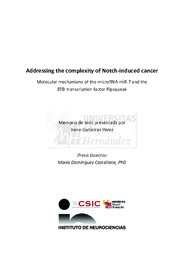Resumen :
Cancer and development are often considered two sides of the same coin, as they both involve the same processes with the goal to expand cell populations. For that, they probably require common genes with the crucial difference that during normal development they are carefully regulated.
Growth control, in developmental biology, has been linked to the establishment of spatially confined domains called organizers, defined by its capacity to instruct surrounding cells about patterning and growth. Clinical evidence implicating various organizer¿forming genes in human carcinogenesis for example, Notch has revived the interest in the connections between growth control and organizers.
In this thesis I have used the Drosophila melanogaster compound eye as a model to study the function of Notch as an oncogene. It has an essential role in eye growth, and its overactivation alone causes mild overgrowth, but never tumour development. We envisioned that in vivo Notch needs the cooperation of additional cofactors. With this work I propose on one hand miR-7 as a new Notch cooperating microRNA and, on other hand, I add new insights to the mechanism behind the tumorigenic transformation of the Notch mediated mild overgrowth by the BTB- transcription factor Pipsqueak.
The microRNA miR-7 is cooperating with the Notch signalling pathway in the Drosophila eye,
being ihog a direct target of miR-7 in this context. At the same time, the functional co- receptor of Hog in the Hedgehog signalling pathway, Boi, is a direct or indirect target of Notch-mediated organizer function. The loss of Hedgehog signalling enhances Notch signalling activity, showing at the same time its unsuspected role as a tumour suppressor. The human counterpart of ihog (CDON) is also repressed by the human miR-7, as it has been demonstrated in vitro in tumour human cells.
It is the first time that Pipsqueak isoforms (with or without a BTB protein ¿protein interaction domain) can be studied independently. This gene has been described to be a Notch cooperating oncogene. Its capacity to induce tumour development in cooperation with Notch overexpression has been attributed to its BTB domain and to its effect over chromatin silencing, as occurs with other
BTB-transcription factors in human cancer. However, and against all predictions, the long Pipsqueak isoforms containing the BTB domain (PipsqueakBTB) does not co-localize with the chromatin repressive machinery, and its function seems to be related to the BTB-mediated insulator function.
On the other hand, the non-BTB isoforms (non-BTB Pipsqueak), has a higher percentage of overlapping binding sites with repressive proteins, predicting a possible role in Polycomb Group-mediated epigenetic function.
|
 La licencia se describe como: Atribución-NonComercial-NoDerivada 4.0 Internacional.
La licencia se describe como: Atribución-NonComercial-NoDerivada 4.0 Internacional.
.png)
